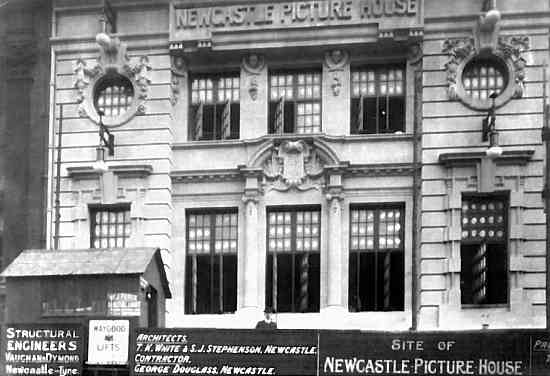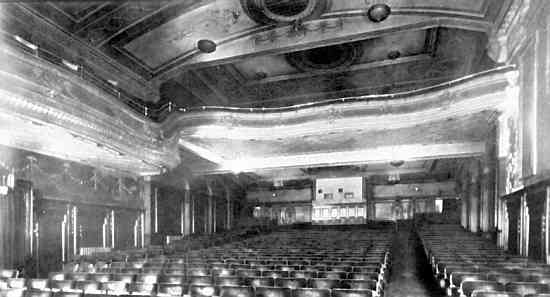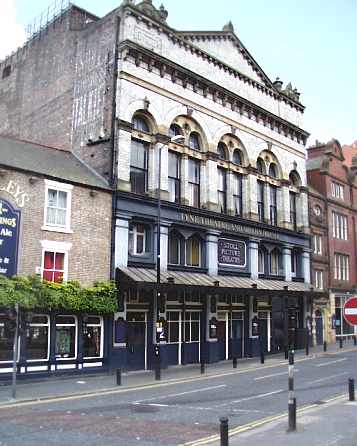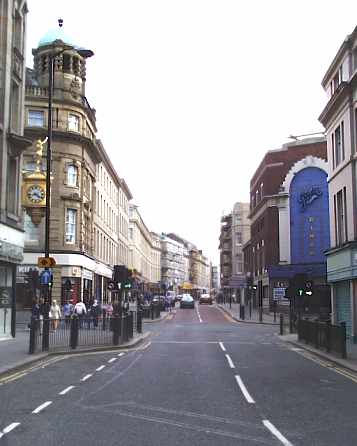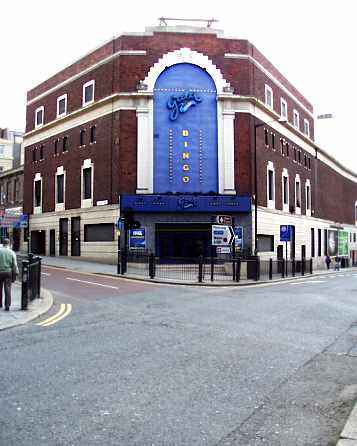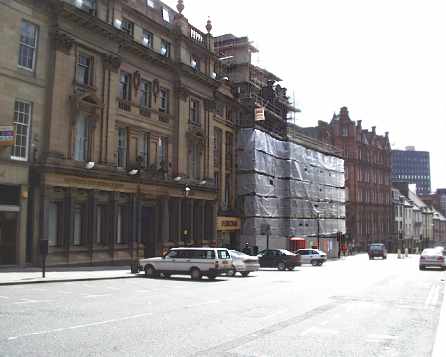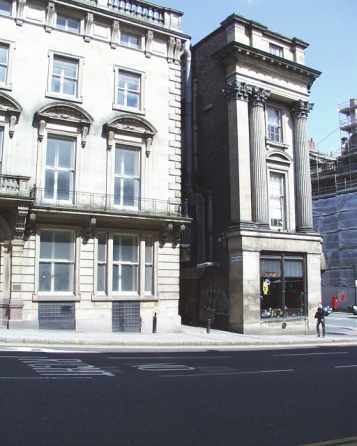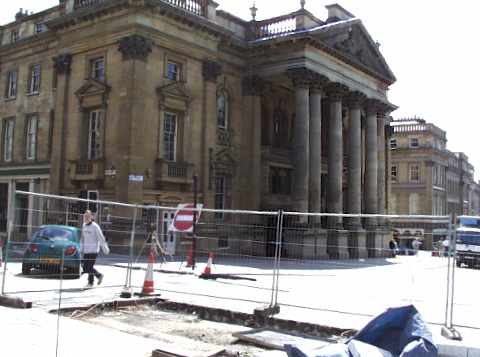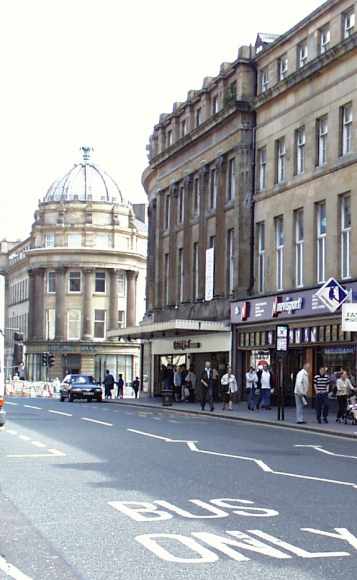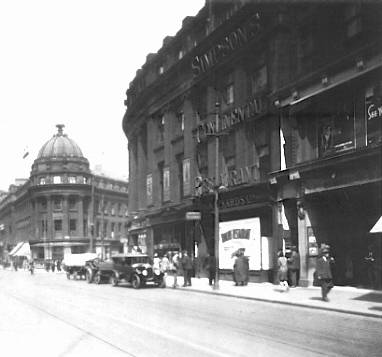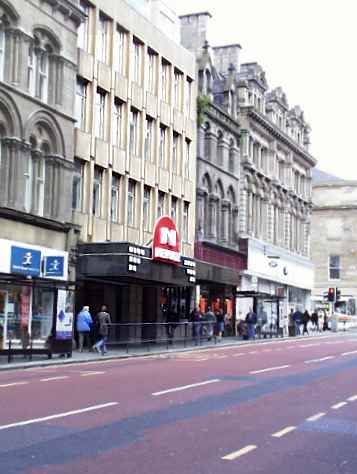|
Theatres and cinemas Saturday 10th June, 2000
|
|
By no means exhaustive, these views are some of the theatre and cinema venues in Newcastle today, or what previous venues look like today.
|
|
|
 |
First, here is the Tyne Theatre and Opera House, built by Joseph Cowen. He
lived during the latter half of the 18th century, and was the city's Member of Parliament as well as the proprietor of the still prosperous Newcastle Chronicle newspaper. He bought up the land surrounding
The Crown Inn, an older coaching stop with stabling yards on Westgate Road. He built the theatre in 1867, and for its day, it was the best equipped in the north. It was later converted to a cinema and, as
The Stoll (see the now faded lettering on the brick side), showed the first talkies. |
|
 |
|
During the 1980s it was restored as a theatre, and survived a devastating fire shortly after its grand reopening. It now hosts popular
variety and musical productions. |
 |
|
Here is the view looking north along Clayton Street. This popular shopping street was once a main
thoroughfare from the Central Station and the now demolished Marlborough Crescent Bus Station to Blackett Street and Eldon Square. Clayton Street traders, therefore, gained passing trade from visitors
arriving in the city.The Northern Goldsmith's clock, left, is one of two in the city, the other being at the junction of Pilgrim Street and Blackett Street. The Gala bingo hall on the right of the
junction stands on the site of the previous Picture House that burned to the ground in 1919. The picture below shows the same view in 1915. I would not now like to pass the time chatting in the middle of
the road like that policeman! |
|
|
 |
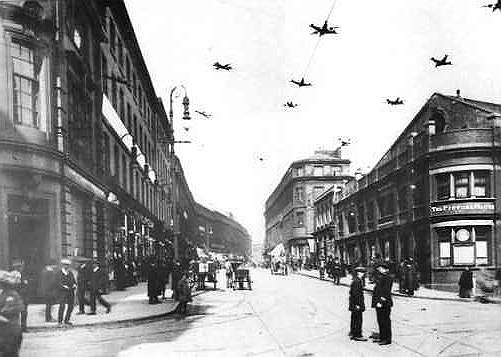 |
|
|
 |
 |
|
The Gala Bingo Hall was previously the Majestic dance hall, built in the 1920s. It was a favourite haunt of successive
generations of youth.Its stark straight utilitarian lines, somwhat at odds with Richard Grainger's fine architecture all around, must have caused comment at the time. To us this bare brick boxyness is
quite common, but in an age that harked back to Regency and Classical Greece this must have seemed ultra modern and tasteless. |
|
 |
|
Not to be confused with The Picture House, The Newcastle Picture House was another purpose built cinema. Above, on the eve of
opening, 1914.Lower down, hiding behind the plastic sheets at the foot of Grey Street, this corner building is undergoing a long awaited restoration that should bring the block back
from dereliction to commercial use once again. |
|
|
|
|
 |
 |
|
Those plastic sheets are just visible here, the junction of Mosley Street and Grey Street. The narrow lane is called Drury Lane, after the theatrical street in London, and is the original site of the Theatre Royal in the city.
If you can imagine that Grey Street did not exist, and that rather narrow looking building on the right extended across the junction you can get some idea of the old building, erected in 1778. It was a
low two storey plain frontage with a low flat portico supported by four Corinthian Columns. It was demolished by Richard Grainger in the 1830s, amid much outcry at the time. The only
way he could go ahead was to promise to build a bigger and better theatre and new covered markets as part of his development. |
|
 |
|
Still surrounded by construction work, this time designed to banish the motor car from the vicinity, Graniger's magnificent
Theatre Royal stands proud here at the junction of Grey Street and Market Street. |
|
|
|
|
 |
 |
|
Here, at the junction of Grainger Street and Market Street is the domed corner of the triangular Central Arcade shopping
precinct built at the same time. The building also housed the Central Exchange.To the right of the picture is the present premises of Nevisport, an outdoor clothing and camping shop. This is the site of
the Grainger Cinema, clearly seen in the 1928 photo below. Beyond the foyer there were two levels, the street level ground floor was the grand circle, and the central stairs led to the stalls in the
basement. The distance between the street entrance and the screen at the rear is deceptively small, and it is hard to see how rows of seats to accommodate 350 or so could have been squeezed in. |
|
 |
 |
|
Simpson's Continental Restaurant boasts that it is a Billiards Restaurant on the white window hoardings. The strange vehicle
behind the car parked on the right is a tractor owned by the London and North Eastern Railway Company to transport goods around the city on horse carts.The Grainger Cinema entrance is on the extreme
right. It was closed in 1960 |
|
|
|
|
 |
A little further south and on the opposite side of Grainger Street is the entrance to the Newgate Shopping Arcade. The new chunk clearly contrasts with the earlier buildings. Just around the corner to the left at the junction is a massive 1960s redevelopment, including a gigantic high
rise hotel.The entrance in Grainger Street is on the site of the Empire Cinema. It was built in 1913 and was a conversion of the previous Dunn and Dicks jewellery shop. It was owned by Moss Empires Ltd
who owned the adjoining and well established Empire Theatre. The cinema seated 750, and the 1926 photo below gives some idea of the typical interiors of the day. |
|
|
 |
|
|
 |
|
If you should arrive here via a search, or be missing the navigation on the left hand side, click this button.
|
|


